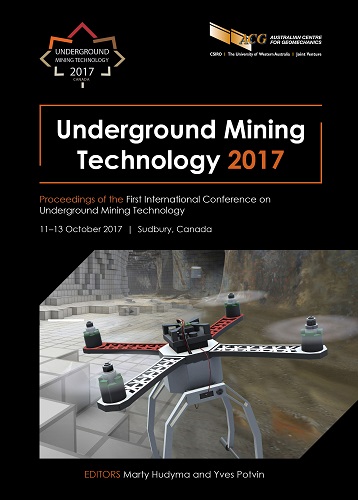Advances in cryogenic chilling technology for deep mines

|
Authors: Cluff, DL; Foster, PJ |
DOI https://doi.org/10.36487/ACG_rep/1710_10_Cluff
Cite As:
Cluff, DL & Foster, PJ 2017, 'Advances in cryogenic chilling technology for deep mines', in M Hudyma & Y Potvin (eds), UMT 2017: Proceedings of the First International Conference on Underground Mining Technology, Australian Centre for Geomechanics, Perth, pp. 133-144, https://doi.org/10.36487/ACG_rep/1710_10_Cluff
Abstract:
Deep mining presents a challenging environment for materials handling, but geotechnical and thermodynamic aspects are among the most problematic. In this paper, the development of cryogenic chilling and the impact of ancillary cryogenic technologies is discussed. Cryogenic chilling is a straight forward system based on technologies that have benefited from over a century of engineering; thus, are reliable and easily purchased from numerous suppliers. As the depth increases, the simple extension of the delivery piping and installation of local storage and vaporiser systems is all that is required. There is no return circuit required as the liquid exits the vaporiser to become part of the ventilation airflow. This paper will provide an understanding of the physics of cryogenic chilling and preliminary designs of the technologies required to deliver the chilling. The concept of chilling on demand is discussed in terms of providing consistent temperatures given varying heat loads. The introduction of electric vehicles to deep mining has the impact of potentially reducing the ventilation flow by 40 to 50% of that required by legislation when diesel equipment is in use; however, this leads to a high susceptibility to larger temperature changes for lesser amounts of heat introduced. This can be problematic if the flow cannot be increased to carry the heat away, say, just after a blast or in an area that has several electric vehicles in operation, which could produce temperatures beyond the allowable working limits rather quickly. Cryogenic chilling is an on demand system, able to respond rapidly by simply increasing the liquid flow. Not only does the liquid air provide chilling, it replaces some of the air that would be drawn from the surface, which can significantly reduce the main fan power. The concept of cryogenic chilling provides an opportunity for a chilling option that has additional uses, which can be implemented to offset the capital expenditure due to economies of scale. The scaling factor for a liquid air plant is about 0.45, so doubling the capacity from 2,000 to 4,000 tpd requires only 36% more capital expenditure and allows for the option to take advantage of ancillary markets such as the sale of oxygen and argon to the industrial market. Since mines are often remote, energy is expensive, but a cryogenic energy storage system in conjunction with wind or solar power provides for a greater energy penetration. A brief discussion of the energy storage technology is provided in the introduction. Availability of liquid air also provides the opportunity for compressed air on demand systems that deliver chilling simultaneously. An emerging cryogenic vehicle technology from the Dearman Engine Company does the exact opposite of diesel engines; for a 100 kW Dearman engine, about 200 kW of cooling is concurrently delivered in situ. In the near future a techno-economic analysis for the total cost of ownership comparison between a Dearman engine versus a diesel engine will be provided.
Keywords: underground mine environment, mine chilling, cryogenic chilling, liquid air energy storage
References:
Brett, G & Barnett, M 2014, ‘The application of liquid air energy storage for large scale long duration solutions to grid balancing’, EPJ Web of Conferences, vol. 79,
da Cunha, I 2007, Implementing a Sustainable Compressed Air Leak Program, final report of the Ontario Mining Association´s compressed air leak management program, Ontario Mining Association, Toronto, viewed 17 July 2017,
Harris, C & Guse, T 2016, Opportunity for battery powered fleet within the Onaping Depth Project, presentation at MeMo 2016: The Maintenance, Engineering and Reliability/Mine Operators Conference, The Canadian Institute of Mining, Metallurgy and Petroleum, Westmount, presentation 1424.
© Copyright 2025, Australian Centre for Geomechanics (ACG), The University of Western Australia. All rights reserved.
View copyright/legal information
Please direct any queries or error reports to repository-acg@uwa.edu.au
View copyright/legal information
Please direct any queries or error reports to repository-acg@uwa.edu.au